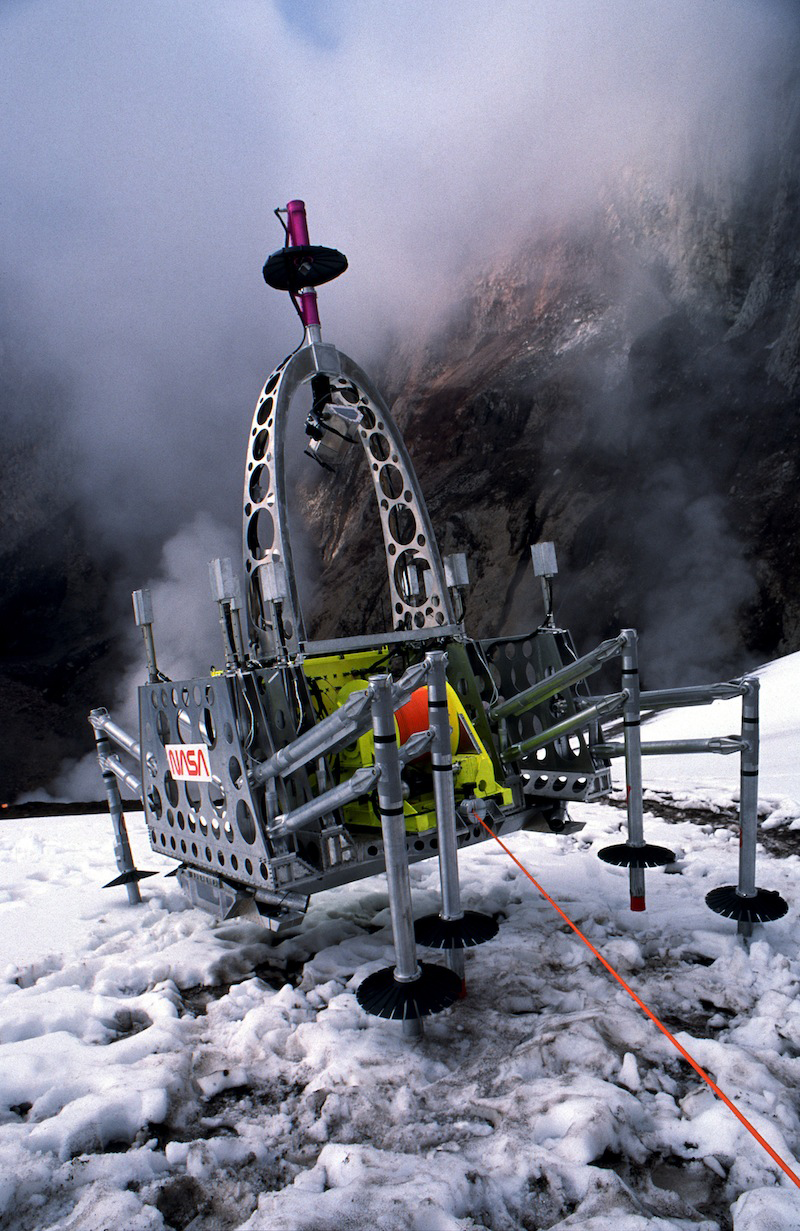
Today, it is difficult to find a major aerospace program that doesn’t have some personal traceability back to CMU.
Dave Lavery
Program Executive for Solar System Exploration
Science Missions Directorate, NASA Headquarters
It is December 1992, and we are perched at the top of Mt. Erebus, an active volcano on Ross Island, just a short hike across the ice from the main continent of Antarctica. The rim is a thin, two-yard-wide ledge that encircles the quarter-mile diameter crater. Covered with snow, ice and loosely frozen crystals of volcanic rock, the footing feels even more precarious than it looks. A slip one way, and it is an 850-foot fall into the crater and down to the open lake of molten lava exposed at the bottom of this huge portal into the mountain. Slip the other way, and it will be a long 12,400-foot tumble down the unbroken slope of the volcano’s exterior, only stopping when you get to the frozen surface of the Ross Ice Shelf more than two miles below. Both possibilities are at the front of our minds as the volcano “burps” and throws a spray of lava bombs and “Pele’s Hair,” thin strands of solidifying volcanic glass, high over our heads.
Admittedly, when 2,200°F molten rock is being tossed about it can be a bit difficult to remember that the security of your position on the rim ledge is not the reason you are here. The primary goal is to deploy and operate Dante, an eight-legged walking robot, inside the crater where it is intended to rappel down the near-vertical crater walls to the lava pool below, collecting science samples and data along the way.
Developed and built by the CMU Field Robotics Center (FRC), Dante is an eight-legged walking robot, a technology proof-of-concept and planetary exploration prototype. Under a grant from NASA, Dante has been developed to create and validate multiple technologies that will one day make their way into robotic explorers destined for Mars. The CMU field team of Red Whittaker, Dave Wettergreen, Eric Hoffman and Dan Christian are backed up with additional support from NASA, the National Science Foundation and the New Mexico Institute of Mining and Technology, as well as the remote operations team back at CMU in Pittsburgh.
Pulled together in just over a year — from initial concept to deployment — the Dante project is attempting to demonstrate that the technologies that NASA will target for use on the Red Planet are ready for some of the most severe environments anywhere. And the chosen way to do that is to field trial an actual remote science mission in some of the most extreme environments on Earth — inside the high-altitude craters of high-latitude active volcanos.
Dante II at the Mt. Spurr volcano in Alaska.
From the mid-1980s through the 1990s, the nascent discipline of field robotics was burgeoning, driven primarily by fledgling applications in subsea and space environments. NASA had developed a huge interest in space robotics capabilities, motivated by the potential for robotic rovers for planetary surface exploration and on-orbit robotic servicing systems typified by the Flight Telerobotic Servicer (FTS) system for the International Space Station. Resulting from this was a national effort to develop enabling technologies to move applications of robotic systems from rigidly defined factory floor settings to highly unstructured environments with unpredictable interactions.
At least in part, leadership of this push was provided by the NASA Telerobotics Intercenter Working Group (TRIWG), which identified needed investments, technical assessment and strategic guidance to the national robotic programs. The FRC took their place as one of only two university participants in TRIWG, based on the existing FRC leadership in applications that bridged the national needs.
For more than a decade and a half, TRIWG leveraged the internal NASA field center knowledge of the development of space systems with the FRC’s ability to instantiate audacious implementations of the generation-after-the-next versions of creative TRIWG visions.
With the direct, hands-on collaboration of the CMU Field Robotics Center and the NASA field centers, the TRIWG community became one of the most productive and cohesive discipline technology development programs in the nation. The team created fundamental robotic technologies that were critical to almost every space robotic system flown by NASA since then. The direct offspring of TRIWG include the Mars Pathfinder rover Sojourner, the AERCam free-flying space camera platform, the Mars Exploration Rovers Spirit and Opportunity, the robotic arms for the Phoenix and Insight Mars Landers, Robonaut 2 flying on International Space Station, the Perseverance and Curiosity rovers, the Lunar Electric Rover, the National Robotics Engineering Center, and too many component technologies to mention.
By the end of the Dante deployment on Mt. Erebus, the CMU team successfully demonstrated multiple robotic technologies on the mountain. Techniques including walking with intrinsic gait planners, advanced control execution, precursors to the D* traverse planner, single actuator drives for multiple legs, robotic rappelling for descent of vertical slopes, capaciflector proximity sensors for footfall placement, remote robot operations via the U.S. Tracking and Data Relay Satellite System (TDRSS), and many others, were all shown to be viable for use in extreme environments. Although the plan for remote science operations at the bottom of the M.t Erebus crater was cut short by a severed fiber optic cable, this capability was demonstrated 18 months later by Dante II in the crater of the Mt. Spurr volcano in Alaska, successfully concluding the objectives of the project.
But even more important than the technologies validated through the Dante project and similar endeavors, the real products of the last 30 years of SCS/FRC projects were the people that emerged from the efforts. The program has produced an amazing legacy of students who have perfused throughout the aerospace community. Today, it is difficult to find a major aerospace program that doesn’t have some personal traceability back to CMU, the TRIWG program and the teams they built. The students, researchers and developers have disseminated the last 30 years of knowledge they created out to the aerospace world in the most effective way possible — by graduating into that community and becoming the engineering, science and design leaders that are now guiding the next 30 years of space exploration. ■


